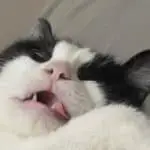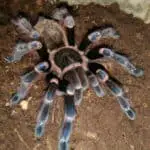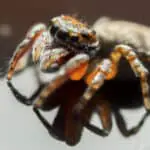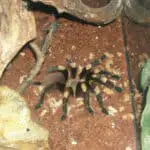Have you ever found yourself cozily settled on the couch, only to have your feline friend hop up and start kneading your chest with their tiny paws?
This peculiar yet endearing behavior, common among our whiskered companions, is a source of both amusement and curiosity for cat lovers. But what drives this instinctual action? Is it a simple show of affection, or is there more to this kneady-kitty phenomenon?
Join me as we delve into the fascinating reasons behind why our beloved cats choose our chests for their kneading escapades, unraveling the mysteries of this quintessential cat behavior.
Seeking Comfort

Have you ever wondered why your cat seems to treat your chest like a dough-making station? This endearing behavior, known as kneading, goes back to their earliest days of life. Picture a tiny kitten, eyes barely open, pawing at their mother.
This action stimulates milk flow, providing the kitten with nourishing food. But it’s more than just a mealtime ritual; it’s a moment of pure comfort and security, surrounded by the warmth and protective presence of their mother.
Fast forward to today, and your cat still carries this instinctual behavior. When they knead your chest, it’s more than a physical action; it’s a throwback to those feelings of safety and contentment. Your lap or chest becomes a substitute for their mother’s nurturing presence.
The rhythmic motion of their paws, often accompanied by a blissful purring, is a sign that they’re reliving that fundamental comfort and security they experienced as kittens.
Marking Territory
When your cat kneads your chest with their little paws, there’s more happening than just a cute display of affection. Cats are territorial creatures by nature, and this kneading behavior is closely tied to their instinct to mark territory. But how does this relate to them choosing your chest as their personal canvas?
Here’s the fascinating part: cats have scent glands located in the soft pads of their paws. When they press their paws into your chest, they’re not only showing affection but also leaving behind their unique scent. This scent-marking is a cat’s way of claiming their territory, and in this case, the territory is you!
By marking you with their scent, your cat is saying, “You’re part of my world.” It’s a sign of ownership, but in the most affectionate sense. This behavior harks back to their wild ancestors who marked their territory to establish their domain and ward off intruders.
In your home, where your cat feels most comfortable, they mark their favorite spots – and that includes you, their beloved human. This scent-marking strengthens the bond between you and your cat, reinforcing your status as an important and cherished part of their life.
Preparing the ‘Bed’
When your cat begins their kneading routine on your chest, they’re engaging in a behavior that’s deeply rooted in their natural instincts. This ritual isn’t just a display of affection; it’s a throwback to their wild ancestry. In the wild, cats used kneading as a way to prepare their sleeping area, turning the environment into a comfortable and cozy bed.
Imagine a wild cat in a natural setting: before settling down for a rest, they would paw at the ground, leaves, or grass to create a soft and comfortable spot. This kneading would help flatten the area, making it more suitable for lying down. It also served to uncover any hidden dangers, like sharp sticks or stones, ensuring a safe and snug resting place.
Bringing this instinct into your living room, when your cat kneads on your chest, they’re replicating this ancient practice. Your lap or chest becomes their ‘bed,’ and their kneading is their way of making it just right for a nap. It’s a sign that they view you as a safe and comfortable space, akin to the perfect resting spot in the wild.
Showing Affection

In the world of feline behavior, kneading is a gesture rich in affection. When your cat kneads your chest with their paws, it’s much more than a simple physical act; it’s a profound expression of love and attachment. This behavior, often accompanied by a contented purring, is one of the most genuine ways your cat shows affection.
Originating from their days as kittens, when kneading was a way to stimulate milk flow from their mother, this action is deeply ingrained in every cat. As they grow older, cats continue to knead, but the context shifts from a survival action to one of affection. When your cat kneads you, they’re revisiting those early feelings of comfort and warmth, but now, they’re directing these feelings toward you.
This kneading behavior is a cat’s way of saying, “You are my safe place, my comfort zone.” It’s a gesture that communicates their trust in you and their comfort in your presence. When your cat chooses your chest for this ritual, it’s a sign of their deep bond with you, indicating that they view you as a source of comfort and security.
Instinctive Behavior
Kneading, a common behavior seen in cats as they press their paws rhythmically against soft surfaces, is much more than a quirky habit; it’s an instinctive behavior deeply embedded in their nature. This rhythmic action, often observed when cats are on their owner’s chest, is a fascinating blend of instinct and emotion.
This behavior stems from their earliest days as kittens. When nursing, kittens knead their mother’s belly to stimulate milk flow. This instinctual action ensures their survival, making it a fundamental part of their early development.
As they grow into adulthood, though the need for milk disappears, the kneading behavior persists. It transitions from a survival tactic to a soothing ritual, deeply ingrained in their behavior.
For adult cats, kneading becomes a way to express contentment, to create a comfortable resting area, or to show affection. When your cat kneads your chest, they are following an instinctive pattern that dates back to their kittenhood. This behavior is hardwired into their system, a part of their genetic makeup.
Relaxation and Pleasure
When your cat kneads your chest with their paws, they’re engaging in a behavior that’s not just instinctual, but also a source of immense relaxation and pleasure. This rhythmic pressing action, often accompanied by a soft purring, is a clear indicator of your cat’s contentment and happiness.
Kneading is akin to a meditative practice for cats. As they rhythmically move their paws, they enter a state of deep relaxation, often closing their eyes and purring in bliss. This behavior releases endorphins in their brain, similar to how humans feel a sense of wellbeing during activities like massage or meditation. It’s a self-soothing behavior that brings them comfort and joy.
When your cat chooses your chest as their kneading spot, it’s a sign that they associate you with this feeling of tranquility and happiness. You’re not just their owner; you’re a source of great comfort and pleasure. This act of kneading is their way of unwinding and expressing their contentment in your presence.
Stretching Muscles

When your cat kneads your chest, it’s not just an expression of affection or comfort—it’s also a mini workout for them. This action, often seen as a sign of contentment, serves a practical purpose: it helps your cat stretch and strengthen their muscles.
Cats, like many animals, have a natural instinct to keep their bodies agile and limber. Kneading is one of the ways they maintain this flexibility. The motion involves extending and retracting their claws, along with a rhythmic pressing of the paws.
This movement engages the muscles in their paws, legs, and even their shoulders and back. It’s a comprehensive exercise that helps keep their muscles toned and their joints supple.
The act of kneading mimics the stretching exercises that many animals (and humans) do instinctively. For your cat, each press of the paw is akin to a small stretch, keeping their muscles in good condition and promoting better circulation.
This is especially important for indoor cats, who may not get as much physical activity as their outdoor counterparts.
Seeking Attention
When your cat kneads your chest with their little paws, it’s more than just a comfort-seeking behavior or an instinctive ritual; it’s often a deliberate attempt to seek your attention. In the nuanced language of feline behavior, kneading can be a way for your cat to communicate with you, to say, “Hey, look at me!”
Cats are known for their independence, but they also crave interaction and affection from their human companions. When your cat chooses to knead on your chest, it’s a clear sign that they want to engage with you. This action is their way of initiating contact, drawing your focus away from anything else and onto them. It’s as if they’re saying, “I need some love and attention right now.”
This behavior is particularly common in cats who have formed a strong bond with their owners. They understand that kneading is a behavior that often elicits a response, whether it’s petting, talking, or simply acknowledging their presence. For your cat, this interaction is a crucial part of their social life and emotional well-being.
Because It’s You
There’s a special reason why your cat may choose to knead specifically on your chest, and it’s deeply rooted in your unique bond. This behavior, while instinctual and common across many cats, takes on a personalized meaning when it comes to the relationship between you and your feline friend. In essence, your cat kneads you because, to them, you’re not just any person – you’re their person.
Every cat-human relationship is distinctive, shaped by individual personalities, experiences, and interactions. Your cat’s choice to knead on your chest is a testament to the comfort and trust they find in your presence. It’s their way of showing you’re special.
This action goes beyond the instinctual reasons like seeking comfort or marking territory; it’s about choosing you as their preferred companion.
Cats are often perceived as independent and self-sufficient creatures, but they form deep emotional connections with their owners. By kneading on you, your cat is expressing a level of familiarity and affection that is reserved just for you. It’s a behavior that signifies, “I feel safe, loved, and relaxed with you.”








